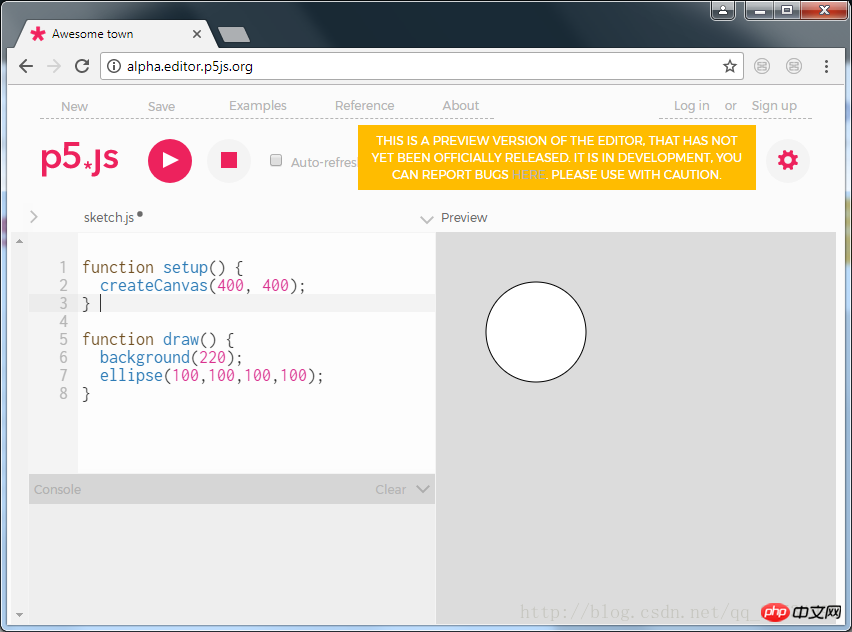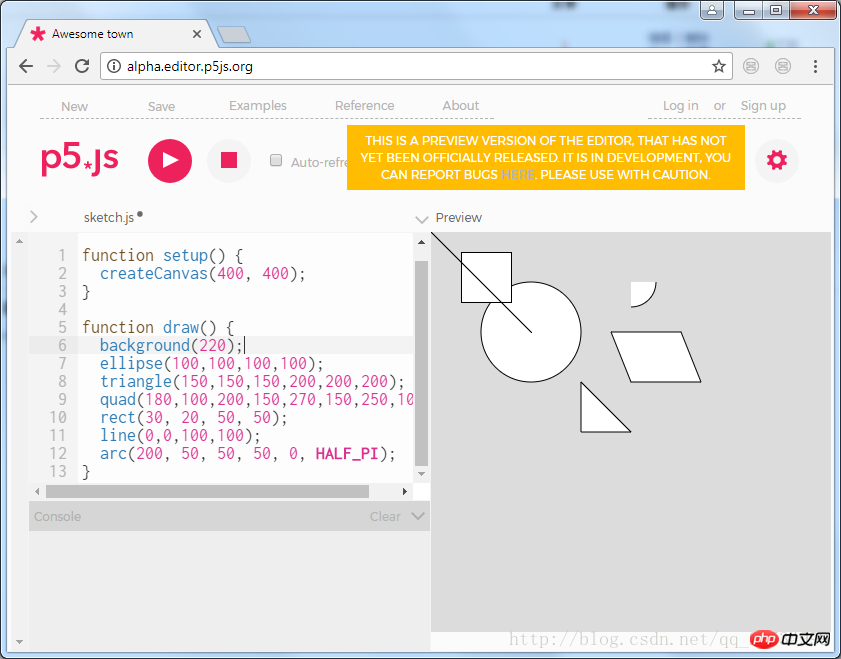p5.js introductory tutorial and basic shape drawing
This article mainly introduces the introduction of p5.js introductory tutorial and basic shape drawing. Now I share it with you and give it as a reference.
1. What is p5.js
I recently came into contact with a digital media art course called Interactivity, which teaches p5.js.
The lecturer is one of the developers... quite excited.
p5.js is a Javascript library developed for artists and designers. It can be regarded as the Web version of Processing. If you have experience in learning Processing, you will get started with p5.js very quickly.
As for the use of p5.js, this question is difficult to answer because I am also a beginner.
I currently think p5.js is a good tool to stimulate creativity, and you can embed the content of p5.js into web pages to make your website more dazzling.
2. Use p5.js
p5.js has an online code editor, the URL is as follows:
http ://alpha.editor.p5js.org/
Enter the code on the left, click the run button, and you can see the code running effect on the right.
You can register a p5.js account, and your code can be saved on the official website every time, which is very convenient for modification, testing or display.
The picture below uses the ellipse() function to draw a circle:

3. Get started with p5.js
When you create a new p5.js project, the following code will be generated:
function setup() { //setup函数,每次程序开始运行时执行一次,用于初始化。
createCanvas(400, 400);//生成一个400x400的画布
}
function draw() { //draw函数,每秒运行60次,不断地在画布上绘制图形
background(220);//绘制背景,颜色为RGB(220,220,220)
}The p5.js program always starts from setup() and executes setup once. (), it enters the continuous loop call of the draw() function.
You can find that the syntax is not much different from JavaScript, it just has a lot more special functions to call.
4. Draw basic graphics
In p5.js, drawing graphics is very easy, and there are many related functions:
function setup() {
createCanvas(400, 400);
}
function draw() {
background(220);
ellipse(100,100,100,100);//绘制椭圆(x,y,宽,高)
triangle(150,150,150,200,200,200);//绘制三角形(x1,y1,x2,y2,x3,y3)
quad(180,100,200,150,270,150,250,100);//绘制四边形(x1,y1,x2,y2,x3,y3,x4,y4)
rect(30, 20, 50, 50);//绘制矩形(x,y,宽,高)
line(0,0,100,100);//绘制线段(x1,y1,x2,y2)起点至终点
arc(200, 50, 50, 50, 0, HALF_PI);//绘制弧(x,y,宽,高,起始角度,终止角度)
}The effect is shown in the figure below:

Of course, the line color and fill color can be replaced, and the line thickness can also be modified:
function setup() {
createCanvas(400, 400);
}
function draw() {
background(220);
stroke(255,128,128);
strokeWeight(5);
fill(255,200,0);
ellipse(100,100,100,100);
triangle(150,150,150,200,200,200);
noStroke();
fill(100,255,0);
quad(180,100,200,150,270,150,250,100);
rect(30, 20, 50, 50);
stroke(0);
line(0,0,100,100);
arc(200, 50, 50, 50, 0, HALF_PI);
}The effect is as shown below:

5. Check Reference
provided by p5.js There are many functions used for creation, and many functions have multiple overloaded functions. I will not explain them one by one here.
p5.js official website provides Reference, which explains each function in detail. You can further learn p5.js by checking the usage of these functions. The URL is as follows:
https ://p5js.org/reference/

The above is what I compiled for everyone. I hope it will be helpful to everyone in the future.
Related articles:
Using axios method in vue component
axios post submission formdata instance
Basic knowledge and working principles of vue-router
The above is the detailed content of p5.js introductory tutorial and basic shape drawing. For more information, please follow other related articles on the PHP Chinese website!

Hot AI Tools

Undresser.AI Undress
AI-powered app for creating realistic nude photos

AI Clothes Remover
Online AI tool for removing clothes from photos.

Undress AI Tool
Undress images for free

Clothoff.io
AI clothes remover

Video Face Swap
Swap faces in any video effortlessly with our completely free AI face swap tool!

Hot Article

Hot Tools

Notepad++7.3.1
Easy-to-use and free code editor

SublimeText3 Chinese version
Chinese version, very easy to use

Zend Studio 13.0.1
Powerful PHP integrated development environment

Dreamweaver CS6
Visual web development tools

SublimeText3 Mac version
God-level code editing software (SublimeText3)

Hot Topics
 How to implement an online speech recognition system using WebSocket and JavaScript
Dec 17, 2023 pm 02:54 PM
How to implement an online speech recognition system using WebSocket and JavaScript
Dec 17, 2023 pm 02:54 PM
How to use WebSocket and JavaScript to implement an online speech recognition system Introduction: With the continuous development of technology, speech recognition technology has become an important part of the field of artificial intelligence. The online speech recognition system based on WebSocket and JavaScript has the characteristics of low latency, real-time and cross-platform, and has become a widely used solution. This article will introduce how to use WebSocket and JavaScript to implement an online speech recognition system.
 WebSocket and JavaScript: key technologies for implementing real-time monitoring systems
Dec 17, 2023 pm 05:30 PM
WebSocket and JavaScript: key technologies for implementing real-time monitoring systems
Dec 17, 2023 pm 05:30 PM
WebSocket and JavaScript: Key technologies for realizing real-time monitoring systems Introduction: With the rapid development of Internet technology, real-time monitoring systems have been widely used in various fields. One of the key technologies to achieve real-time monitoring is the combination of WebSocket and JavaScript. This article will introduce the application of WebSocket and JavaScript in real-time monitoring systems, give code examples, and explain their implementation principles in detail. 1. WebSocket technology
 How to use JavaScript and WebSocket to implement a real-time online ordering system
Dec 17, 2023 pm 12:09 PM
How to use JavaScript and WebSocket to implement a real-time online ordering system
Dec 17, 2023 pm 12:09 PM
Introduction to how to use JavaScript and WebSocket to implement a real-time online ordering system: With the popularity of the Internet and the advancement of technology, more and more restaurants have begun to provide online ordering services. In order to implement a real-time online ordering system, we can use JavaScript and WebSocket technology. WebSocket is a full-duplex communication protocol based on the TCP protocol, which can realize real-time two-way communication between the client and the server. In the real-time online ordering system, when the user selects dishes and places an order
 How to implement an online reservation system using WebSocket and JavaScript
Dec 17, 2023 am 09:39 AM
How to implement an online reservation system using WebSocket and JavaScript
Dec 17, 2023 am 09:39 AM
How to use WebSocket and JavaScript to implement an online reservation system. In today's digital era, more and more businesses and services need to provide online reservation functions. It is crucial to implement an efficient and real-time online reservation system. This article will introduce how to use WebSocket and JavaScript to implement an online reservation system, and provide specific code examples. 1. What is WebSocket? WebSocket is a full-duplex method on a single TCP connection.
 Beginner's Guide: Start from scratch and learn MyBatis step by step
Feb 19, 2024 am 11:05 AM
Beginner's Guide: Start from scratch and learn MyBatis step by step
Feb 19, 2024 am 11:05 AM
Concise and easy-to-understand MyBatis introductory tutorial: write your first program step by step MyBatis is a popular Java persistence layer framework that simplifies the process of interacting with databases. This tutorial will show you how to use MyBatis to create and perform simple database operations. Step 1: Environment setup First, make sure your Java development environment has been installed. Then, download the latest version of MyBatis and add it to your Java project. You can download it from the official website of MyBatis
 JavaScript and WebSocket: Building an efficient real-time weather forecasting system
Dec 17, 2023 pm 05:13 PM
JavaScript and WebSocket: Building an efficient real-time weather forecasting system
Dec 17, 2023 pm 05:13 PM
JavaScript and WebSocket: Building an efficient real-time weather forecast system Introduction: Today, the accuracy of weather forecasts is of great significance to daily life and decision-making. As technology develops, we can provide more accurate and reliable weather forecasts by obtaining weather data in real time. In this article, we will learn how to use JavaScript and WebSocket technology to build an efficient real-time weather forecast system. This article will demonstrate the implementation process through specific code examples. We
 Simple JavaScript Tutorial: How to Get HTTP Status Code
Jan 05, 2024 pm 06:08 PM
Simple JavaScript Tutorial: How to Get HTTP Status Code
Jan 05, 2024 pm 06:08 PM
JavaScript tutorial: How to get HTTP status code, specific code examples are required. Preface: In web development, data interaction with the server is often involved. When communicating with the server, we often need to obtain the returned HTTP status code to determine whether the operation is successful, and perform corresponding processing based on different status codes. This article will teach you how to use JavaScript to obtain HTTP status codes and provide some practical code examples. Using XMLHttpRequest
 How to use insertBefore in javascript
Nov 24, 2023 am 11:56 AM
How to use insertBefore in javascript
Nov 24, 2023 am 11:56 AM
Usage: In JavaScript, the insertBefore() method is used to insert a new node in the DOM tree. This method requires two parameters: the new node to be inserted and the reference node (that is, the node where the new node will be inserted).






